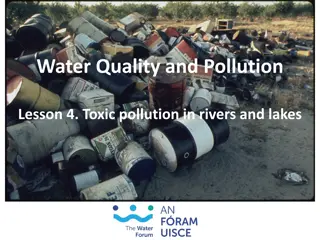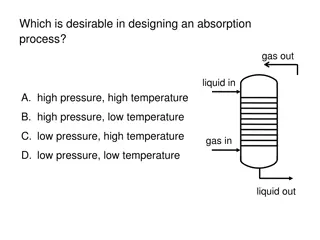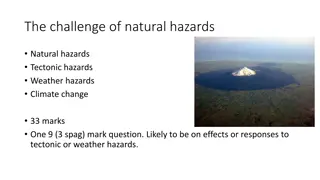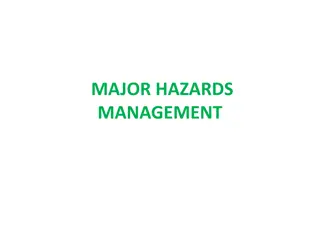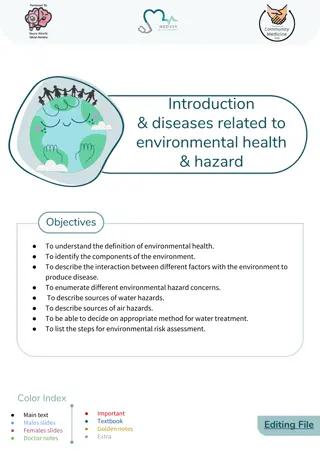Understanding Dermal Hazards: Anatomy, Toxic Absorption, and Health Effects
Explore the key anatomy and physiology of the skin, learn how toxic agents are absorbed, understand the adverse health effects of skin exposure to hazardous agents, discover methods of dermal exposure assessment, and develop controls to minimize skin exposure to dangerous substances.
Download Presentation

Please find below an Image/Link to download the presentation.
The content on the website is provided AS IS for your information and personal use only. It may not be sold, licensed, or shared on other websites without obtaining consent from the author. Download presentation by click this link. If you encounter any issues during the download, it is possible that the publisher has removed the file from their server.
E N D
Presentation Transcript
CHAPTER 10 Dermal Hazards
Learning Objectives Identify key anatomy and physiology of the skin. Understand how toxic agents are absorbed into the body through the skin. Describe several of the most significant adverse health effects of skin exposure to hazardous agents. Explain some of the latest methods of dermal exposure assessment. Develop controls necessary to minimize skin exposure to hazardous agents.
Anatomy of the Skin Source: Franklin and Morgan 2005
Anatomy of the Skin (cont.) Source: snapgalleria/iStock
Main Mechanisms of Diffusion 1) Travel on the intercellular lipid pathway Source: Centers for Disease Control and Prevention
Main Mechanisms of Diffusion (cont.) 2) Trans-cellular permeation Source: Centers for Disease Control and Prevention
Main Mechanisms of Diffusion 3) Through appendages of the skin Source: Centers for Disease Control and Prevention
Main Mechanisms of Diffusion (cont.) Source: Scheuplein 1971
Chemical Exposure Touching contaminated surfaces Being immersed in containers with liquids or semisolids Sedimentation, impact, electrostatic attractions, or chemical splashes depositing aerosols on the skin
Chemical Factors of Absorption Molecular weight Hydrophylic Lipophylic Volatility/vapor pressure
Skin Injury and Illness 33,000 cases per year >$1 billion in costs
Contact Dermatitis Known as eczema An inflammation of the superficial regions of the skin that appears in large localized areas Characterized by inflammation and erythema (reddening) or the formation of scales Symptoms of dermatitis include itching, swelling, pain, burning, rashes, redness, blisters, and dry or flaky skin.
Contact Dermatitis (cont.) Source: Centers for Disease Control and Prevention
Irritant Contact Dermatitis A nonimmunologic reaction that results from direct damage following exposure to a hazardous agent and manifests as inflammation of the skin 80% of all cases of occupational contact dermatitis
Phototoxic Contact Dermatitis Develops only after exposure to UV light, such as sunlight
Allergic Contact Dermatitis An inflammation of the skin caused by an immunologic reaction triggered by dermal contact with a skin allergen or sensitizer Plants (gardening), antibiotics (pharmaceutical industry), dyes (paint and cosmetics industry), metals, chromates (cement industry), adhesives, fragrances, rubbers, resins, pesticides, fertilizers, and cutting oils used in machining
Exposure Pathways Immersion Splashes Deposition Contact with contaminated surfaces
Urticaria A transient skin condition that often appears as a wheal (swelling) and raised patches accompanied by intense itching Caused by skin irritants or allergens and is different from dermatitis because it typically occurs rapidly following exposure and often goes away soon after exposure ceases Caused by detergents, pesticides, rubbers, minerals, and animal toxins such as from caterpillars, jellyfish and certain plants
Acne An inflammatory disease of the sebaceous glands and hair follicles in the skin, leads to pimples and pustules (white-centered bumps) on the surface of the skin Often develops in jobs where workers are exposed to materials like oil, grease, pitch and tar
Systemic Diseases That Result from Skin Exposure Diseases that result in other parts of the body after a dermal exposure Can cause respiratory and neurological effects May lead to bladder cancer, scrotal cancer, and heart or kidney disease
Physical Damage to Skin Can represent a significant hazard in many industries and should not be forgotten. Cuts, abrasions, burns, rashes, cysts, frostbite
Skin Cancer Most common form of cancer Treatment in the U.S. costs $8.1 billion per year 10,000 people die from melanoma each year Polycyclic aromatic hydrogen compounds, creosote and mineral oils have been associated with benign skin cancer. Ultraviolet and ionizing radiations have been closely associated with malignant melanoma
Controlling Skin Exposure Elimination and substitution Engineering controls splash guards, glove boxes, isolation booths Administrative or work practice controls training, good hygiene, access control, procedures PPE footwear, aprons, face shields, overalls, and gloves
Skin Care Products Certain creams can be used to provide a barrier to hazardous chemicals. Moisturizers can be used to treat damaged skin. Cleaners can be used to remove skin contamination. Sun block can be used to reduce effective dose to UV radiation.







